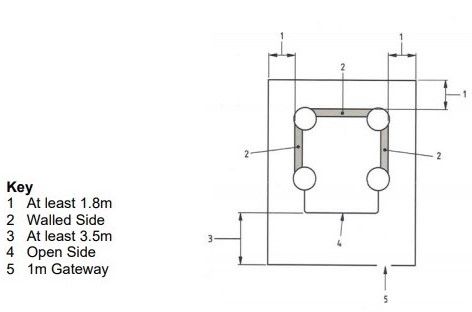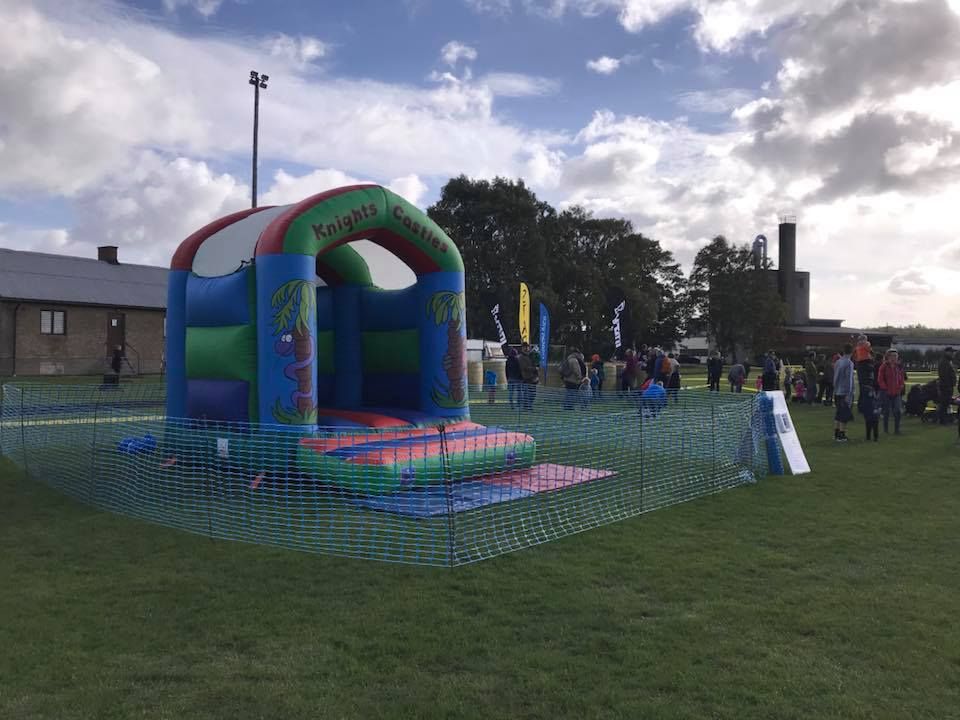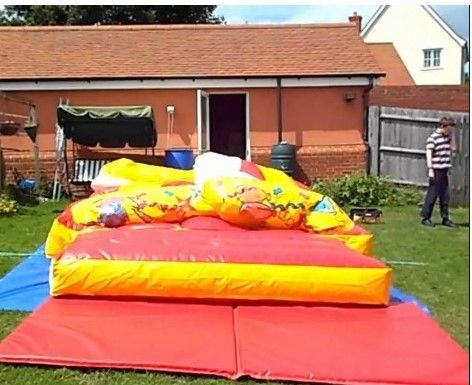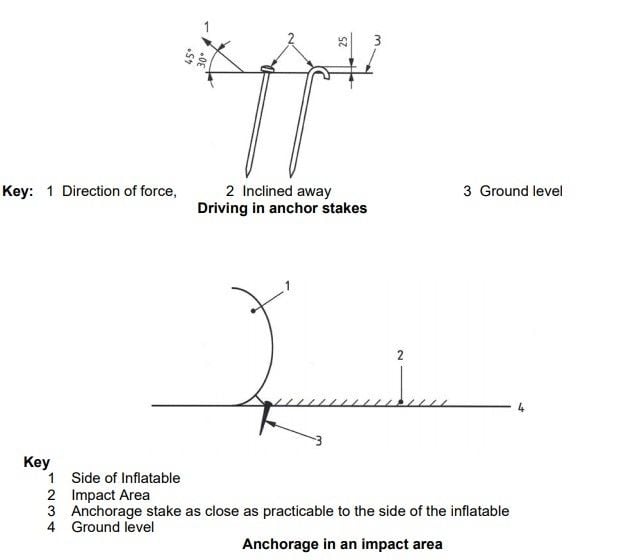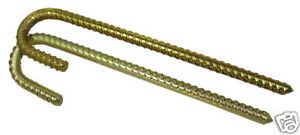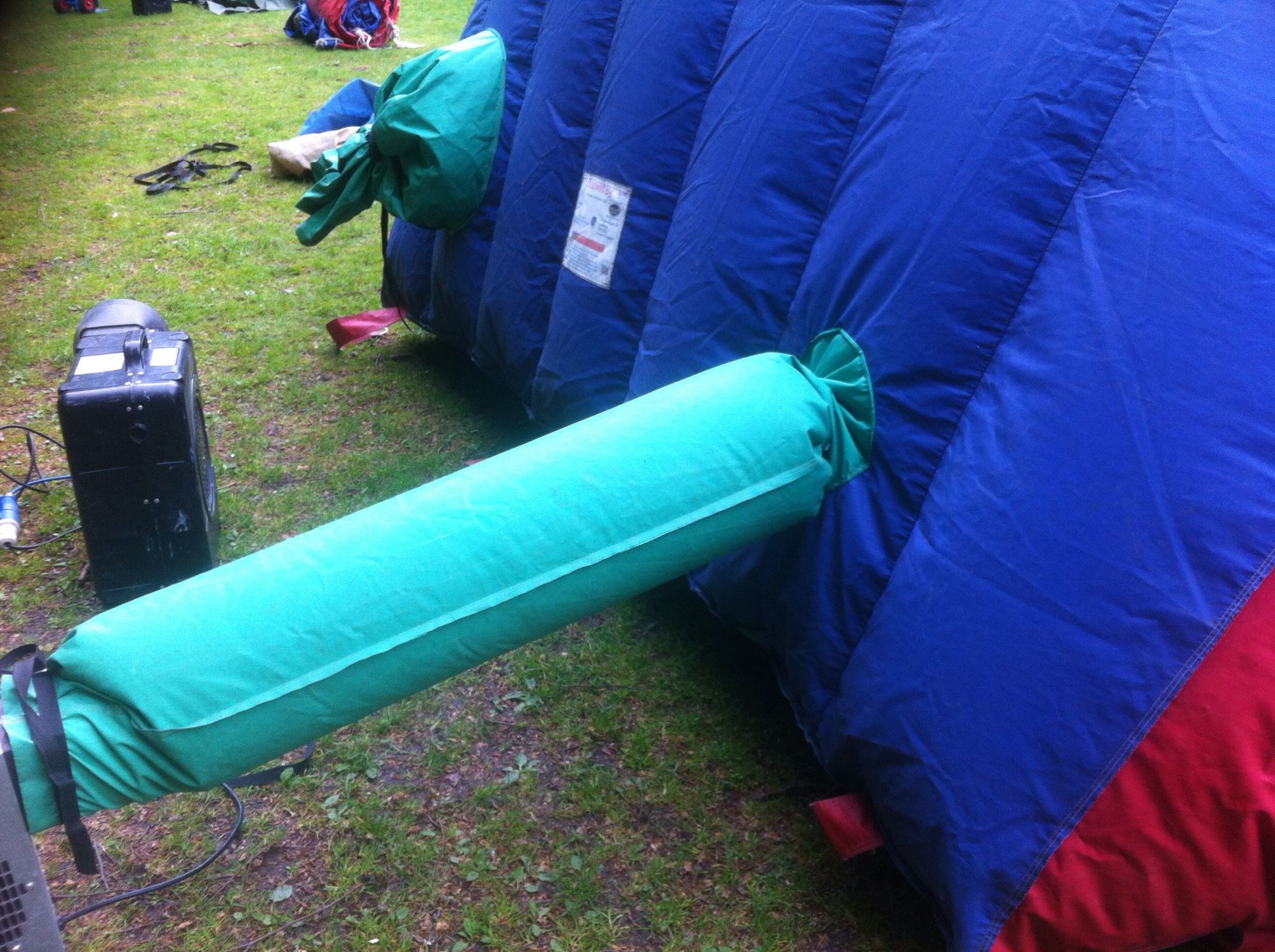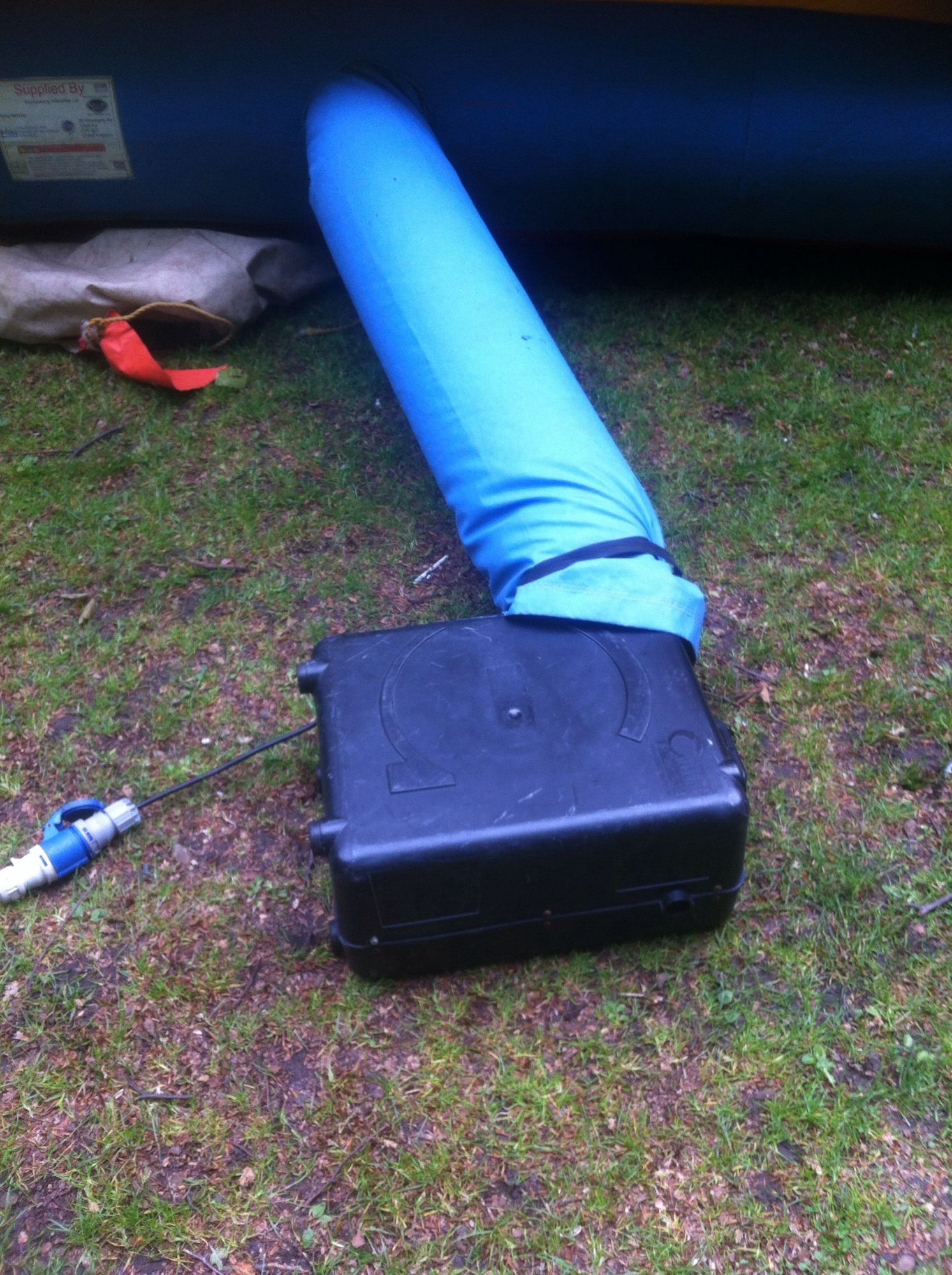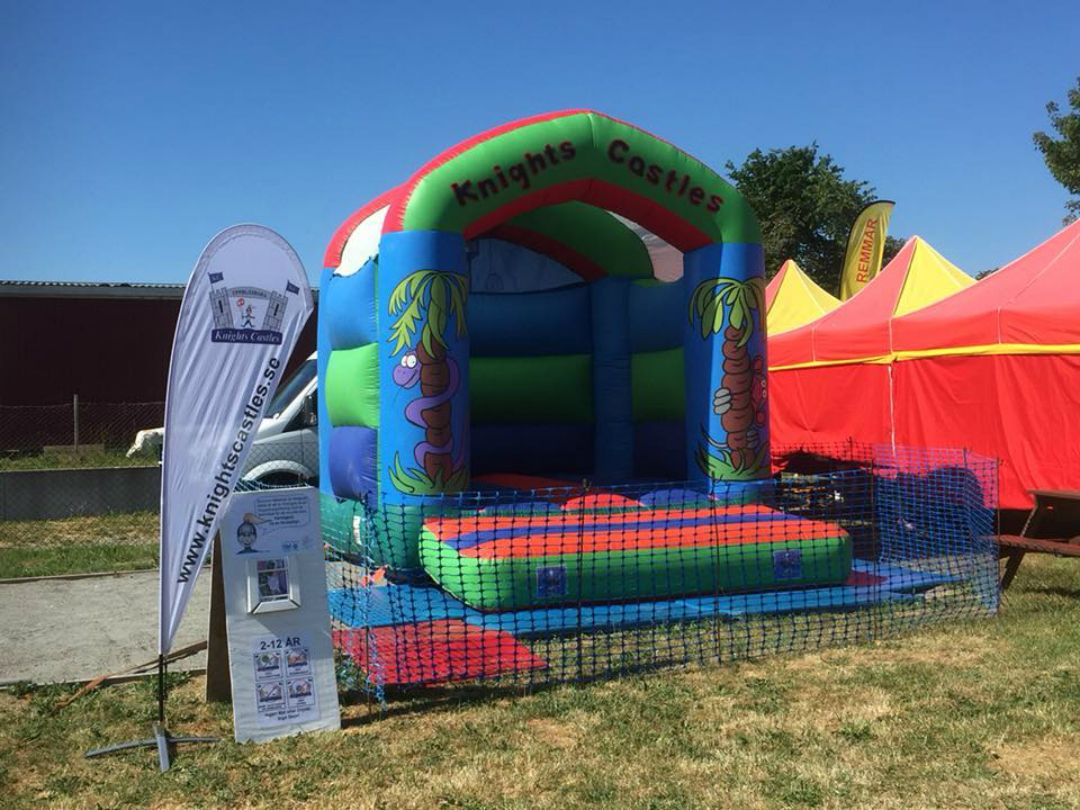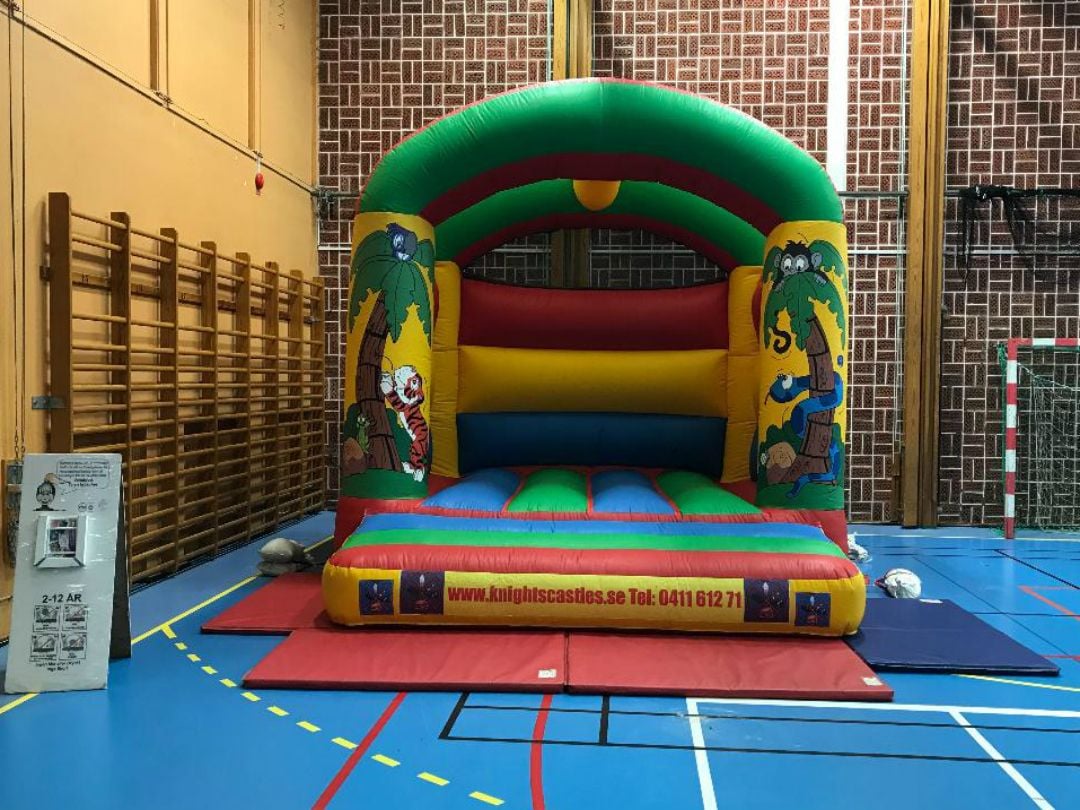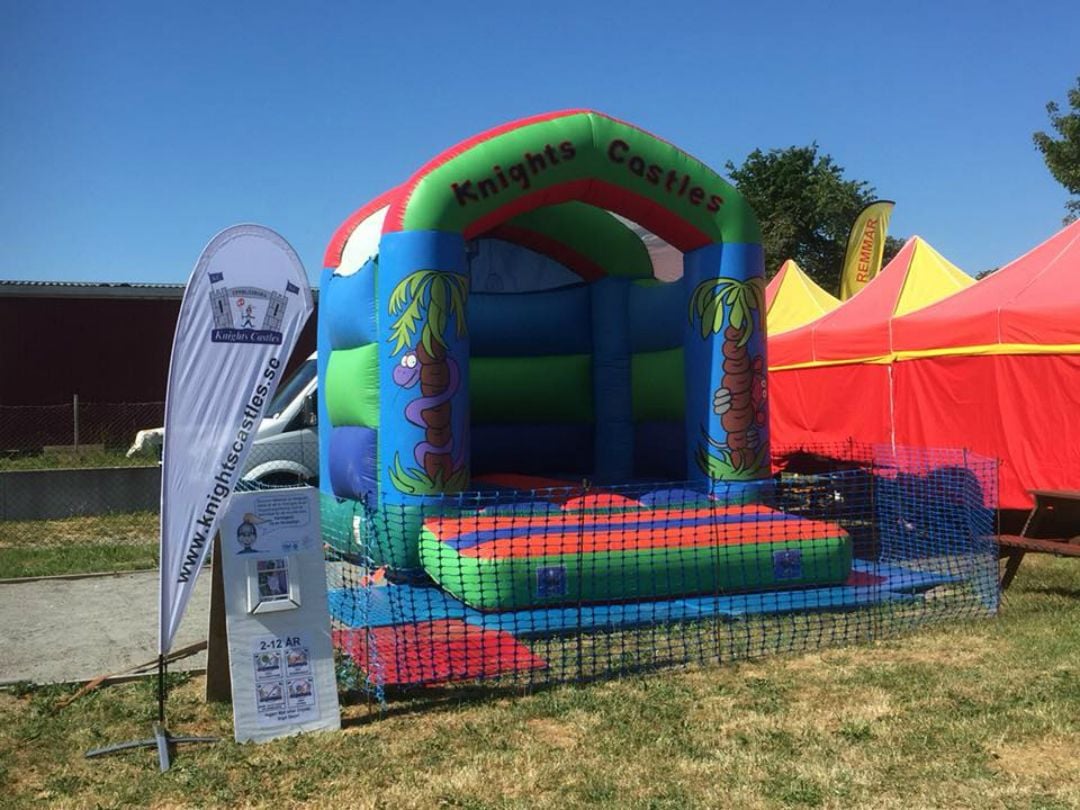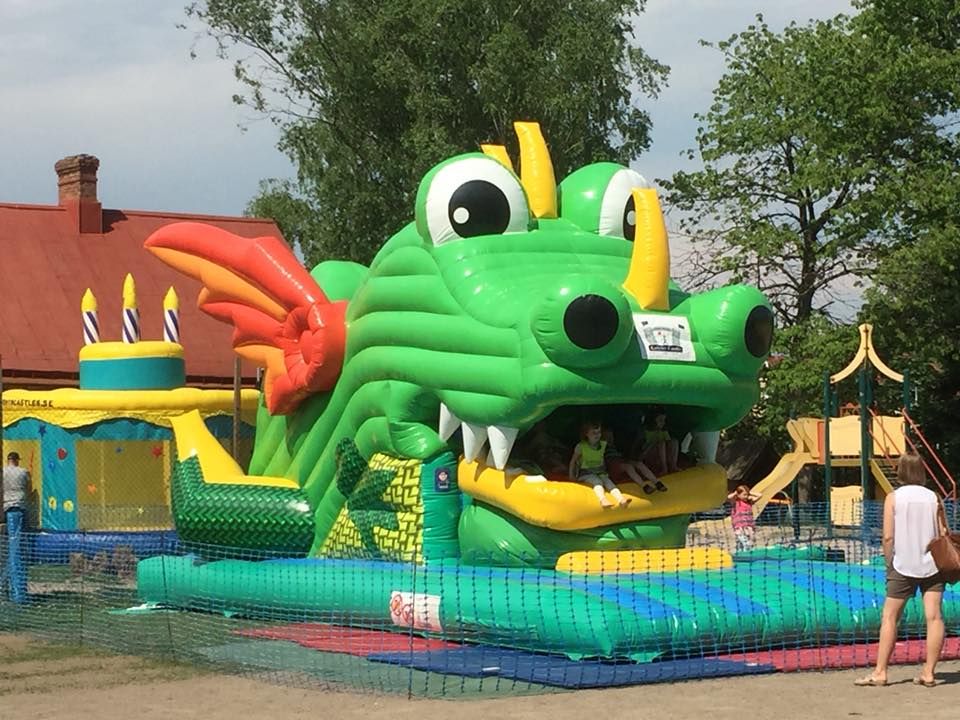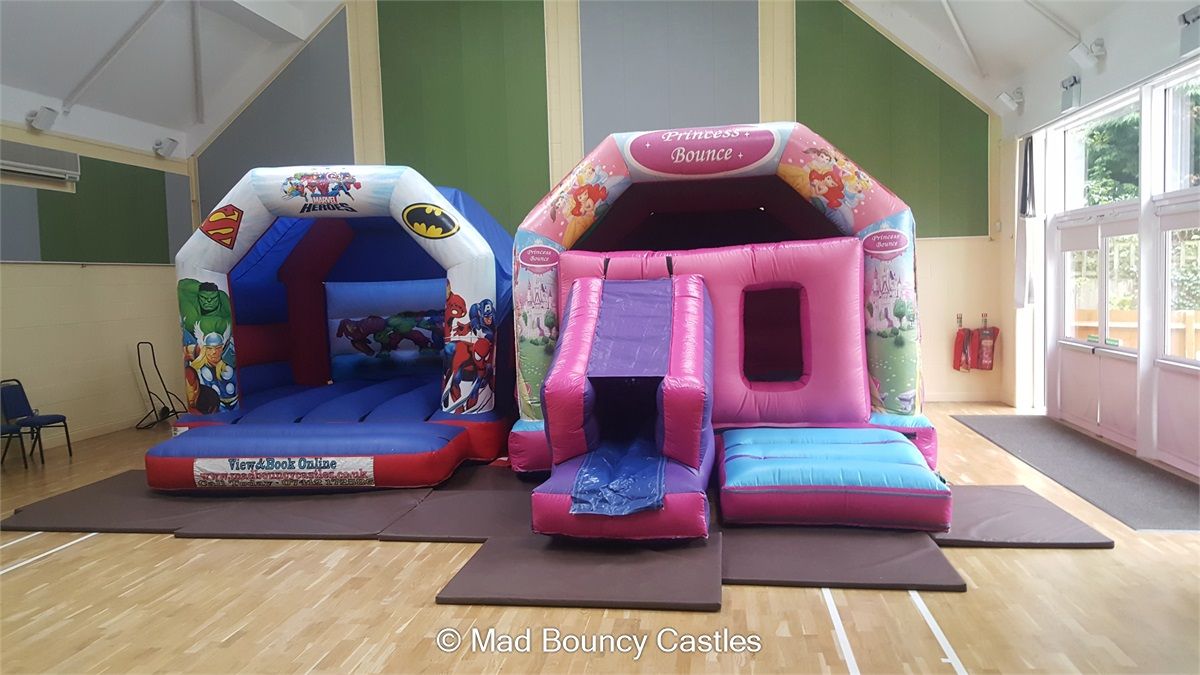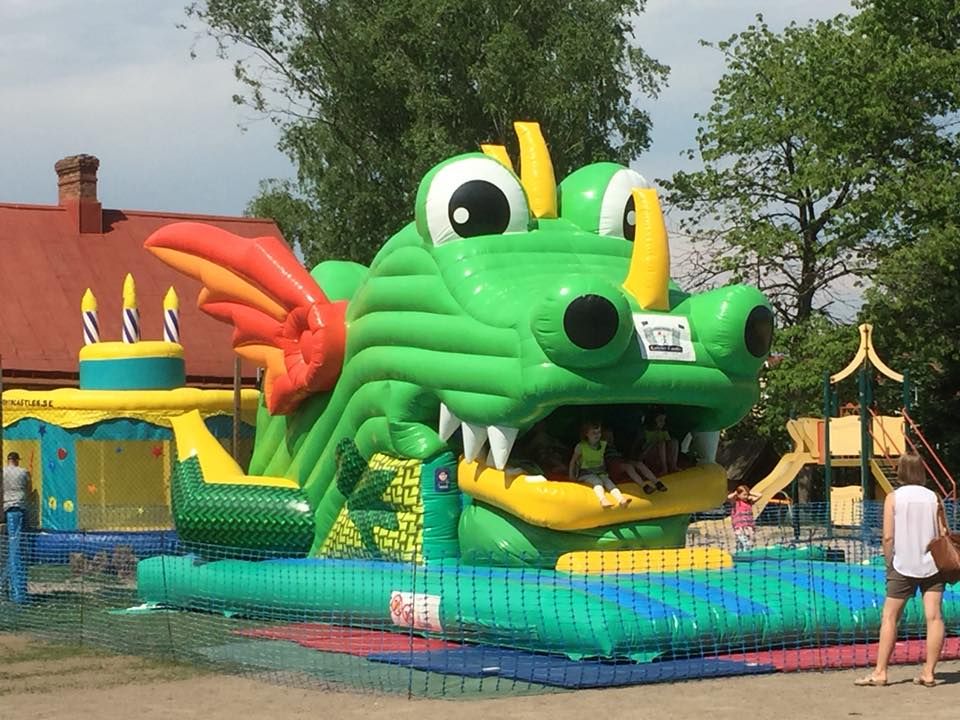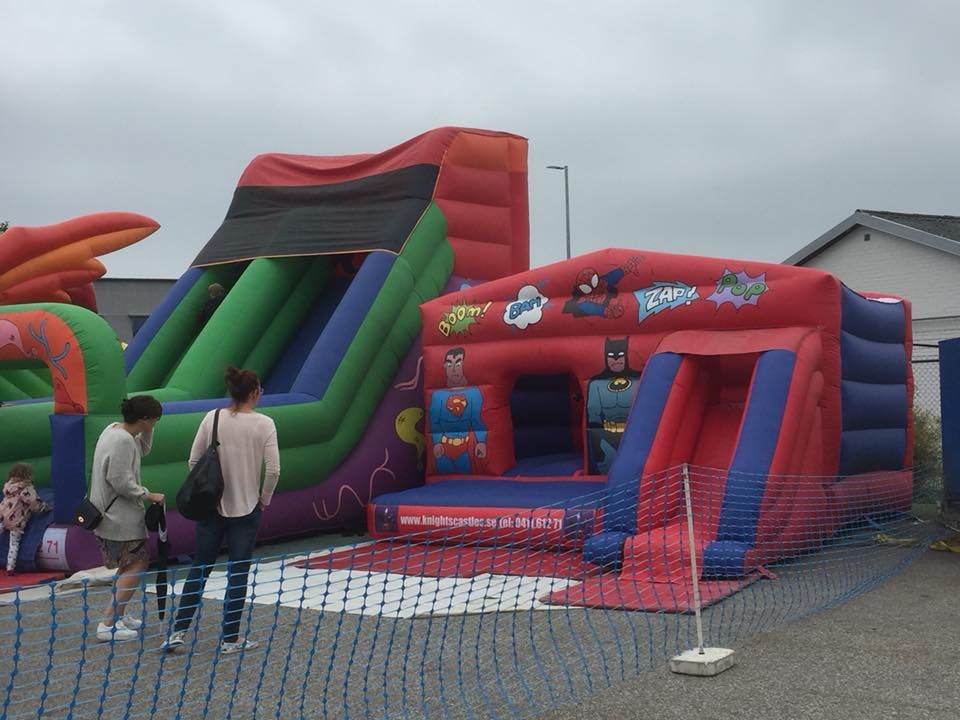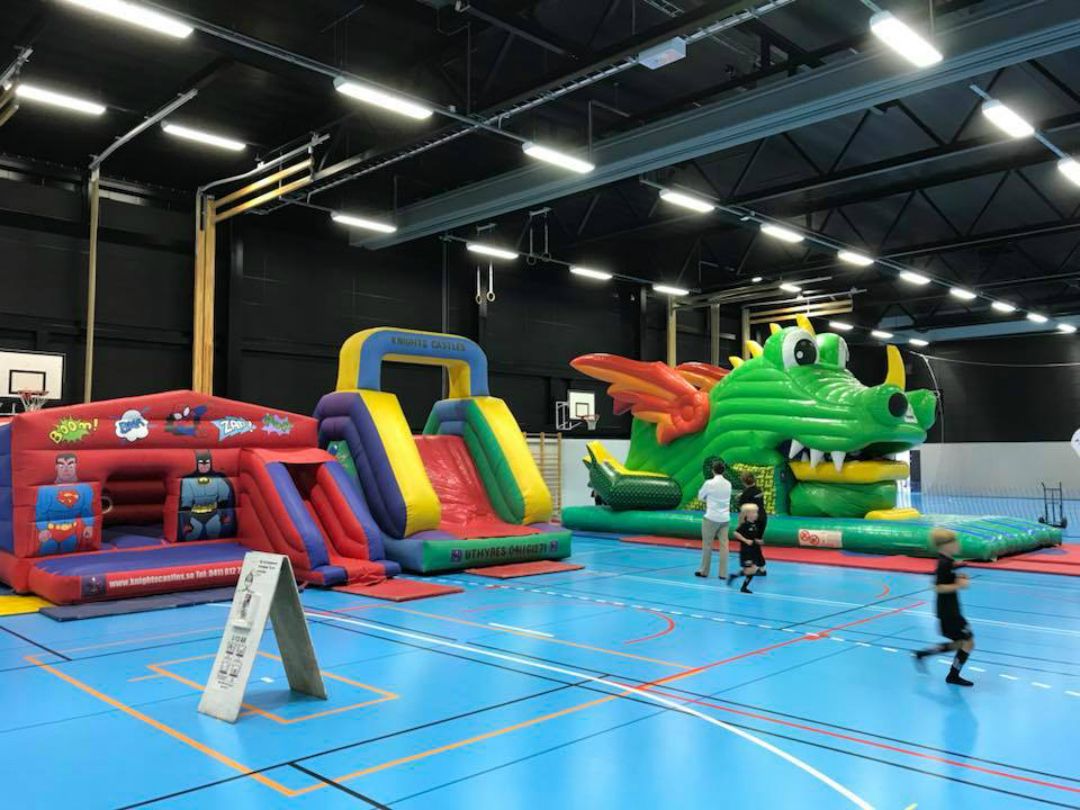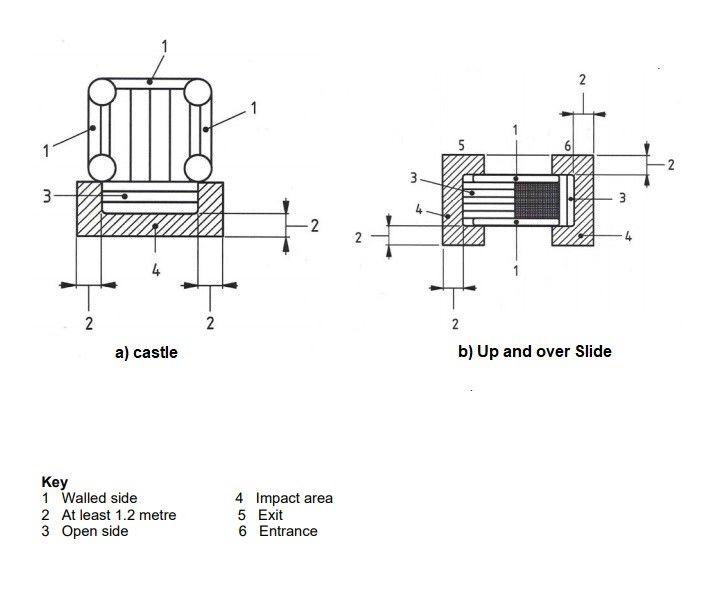General Instructions for Attendants of Children's Inflatable Play Equipment.
Safe handling.
Inflatables can be very heavy and require some care in their handling if injuries are not to be caused. The first requirement for safe handling is that the inflatable was folded and rolled properly after its last use. A good, hard roll, flat at both ends, is so much more easily handled than a floppy heap of PVC. It can be handled and moved on a 2-wheeled sack barrow and easily bowled over onto a truck or trailer. Do not try to lift a complete inflatable. Lift only one end at a time. When the rolled inflatable is lying down, take up a squat position, lean a shoulder into the end and push with the legs. Your leg muscles are the strongest you have and will lift the inflatable onto its end. It can then be easily moved using the sack barrow. When loading the inflatable onto a truck or trailer, stand it up on its end close to the truck or trailer, lean the top onto the edge of the platform and then lift the bottom end and bowl it over.
Tips on rolling up A castle.
Setting up on grass.
Choose your site. The site must be big enough to accommodate the equipment, bearing in mind the open space needed at front and sides and the length of the blow-tube. The site must be level or have a slope of not more than 5 degrees in any direction. The inflatable must be sited well away from possible hazards such as overhead power lines or other obstacles with hazardous projections (e.g. fences and/or trees). The site must be cleared of debris and sharp objects on, or embedded in, the surface.
Positioning of perimeter fence.
If, for crowd-control purposes, a perimeter fence is used, it must be at least 1.8m from walled sides and at least 3.5m from open sides. The gateway must be 1.0m wide. If there are guy-ropes on a high inflatable they must be contained within the fenced area.
How to anchor it down temporarily when windy.
If ropes form part of the anchorage system, attach them to the anchor-points. The windward side of the inflatable needs to be anchored temporarily while it is inflating so drive anchor-stakes into the ground on the windward side and loosely tie on the windward side ropes. Using industry standard 38cm long x minimum 16mm diameter stakes, there is little risk of penetrating underground services. However, you should check that there are no obvious signs of excavation for cable runs, pipes etc. and check with the client for the location of any underground services before driving the stakes in. The wind-speed must be no more than Force 5 on the Beaufort scale(maximum 10.5 m/s /38 km/h)
Inflating
Make sure onlookers keep away. Ensure all electrical equipment is suitable for outdoor use. Check that you have the correct size and type of blower and attach it securely to the blow-tube. Tie up any other tubes and close any zips. Switch on the blower and allow the inflatable to inflate fully. Watch the temporary anchorages you have connected in case they are positioned wrongly and pull tight. If they do pull tight, switch off the blower quickly and re-position either the inflatable or the stake, or loosen the rope. When the inflatable is fully inflated, you can push or pull it into its correct position.
Anchor it down permanently.
You must use every anchorage point on the inflatable because their number and positioning has been calculated for each inflatable. Drive an anchor-stake into the ground for each remaining anchorage point and securely connect the ropes or webbings. The original temporary anchorages might want moving so as to be in the correct position. The stakes need to be positioned so that the ropes or webbings go upwards from the stake towards the inflatable at between 30 and 45 degrees. Moving the stake closer makes the angle bigger. Moving it away makes the angle smaller. The stakes should be driven into the ground slightly inclined away from the inflatable and the ropes or webbings should not be pulled too tight. They should curve gently up to the inflatable so as to allow movement of the inflatable up and down when in use. The stakes should protrude no more than 25mm above the ground. If the inflatable requires anchorages in the impact area, make sure the stakes are as close in to the base of the inflatable as possible. With the slide its important to anchor the side ropes hanging down.
Adjust the position of the blower.
The blower needs to be moved as far away from the inflatable as the blow-tube will allow and then moved forward 50mm so as to leave a little free play between blower and inflatable so that the blower is not pulled when people are bouncing. Note: The blower must stand at least 1.2m away from the inflatable. Make sure the tube is not twisted (left pic) and the blower is not fallen over.(right pic)
Do you need mats at the entrance?
If the grass or earth is soft and not abrasive, it may not be necessary to use landing mats all around the entrance/exit, because soft grass and earth have sufficient impact attenuating properties for the maximum allowed fall-off height of inflatables (60cm). However, if the grass or earth are hard and abrasive, you will need to install landing mats over the whole of the impact area.
Setting up on hard floor outside.
Anchoring On hard standing, you will be unable to anchor with stakes driven into the ground. Each anchorpoint must be attached to something which will withstand a force of 160kg. This could be weights or sandbags, vehicles, provided they are immobilised and under your control, or fittings already in the ground. If you are near the edge of hard standing, you can sometimes anchor the rear and one side of the inflatable with stakes into the ground beyond the hard standing, leaving only one side to be anchored in the ways suggested above. Use a firm standing tree or even a car or trailer if needed.
Use mats
On hard standing you will definitely need landing mats, covering the whole of the impact area, and you will need to be on your guard against them moving when the session is in progress.
Protect the base.
If the hard standing is abrasive, you must use a groundsheet under the inflatable so as not to wear out the base of the inflatable. If the floor is not abrasive, there will be no need to use a groundsheet under the inflatable.
Setting up indoors.
ls the site suitable? You must check that there is enough floor-space on which the inflatable can stand with its blowtube fully extended and that there is plenty of space (3.5m) where the users get on and off. The height of the ceiling must be sufficient to allow the inflatable to inflate fully without touching and high enough to prevent users from touching the ceiling or any other fittings such as lights. If there is some doubt about the height, stand by the blower when inflating so that you are ready to switch off quickly if any part of the inflatable is too tall.
Does the inflatable need anchoring? Much depends upon the size and weight of the inflatable and the size of user. The inflatable will not blow away when indoors, but it could move across the floor and it could overturn. An inflatable with a small base and high side-walls is particularly prone to overturn if there are tall users and they make a concerted effort to run from side to side throwing themselves against the walls. This type of action on any small inflatable will at least cause the inflatable to move sideways thus putting the blower out of position and threatening to pull the blow-tube off of the blower. This tendency can be combated by the use of weights tied to the anchor-points, or by attaching the anchor-points to gym bars or any other secure fittings. Sideways movement can be counteracted by placing rubber mats under the inflatable.
You will definitely need to use landing mats to cover the whole of the impact area and be wary of them moving while the equipment is in use.
Where is the impact area?
The impact area has been mentioned several times previously. It is the area of ground immediately next to any open side of the inflatable and it extends to 1.2m away. For instance, on an ordinary castle with 3 walled sides and one open side with a full width step, it is the area, shaped like a U, all around the step. Here are a few common examples:
Routine Inspection.
When everything is set up and before the users are allowed on, the equipment needs to be inspected to see that all is as it should be. Primarily we are looking for any damage which might have happened last time the equipment was used. This is a final check of all of these points as you will have been mentally checking everything as you set the equipment up. Here are the main items you should now check again:
1) The site is level enough? No overhead wires/trees? Plenty of clear space around the inflatable?
2) AII of the anchorages are in place and secure?
3) Landing mats, if needed, are in position?
4) No significant rips or holes in the fabric and seams?
5) Internal pressure sufficient? If its half flat due to lack of air or a zipper is open?
6) Correct blower?
7) Firmly connected to the blow-tube?
8) Blow-tube at its furthest extent?
9) No exposed electrical parts or wires?
10) No damage to switches, plugs, sockets?
11) Cables routed out of harm's way?
12) All electrical appliances are covered from rain / water?
13) Electrical reels fully unwound
If any faults are found during routine inspection, they must be corrected before commencing operation. Repairs must not be carried out while the equipment is being used.
Operating. Who's who?
Operators and attendants need to be identifiable. This is usually achieved by wearing a uniform or part of a uniform which both users and onlookers can recognize. Perhaps a tabard or even a Tshirt with "I'm in charge" emblazoned across it. The operator needs to be able to exercise some authority over the users. He/she needs to carry a whistle. A whistle, hung around the operator's neck, immediately confers authority.
Attendant's duties
The attendant's first duty is to organise the users into groups of roughly similar height. Standing so as to block the gate, the attendant surveys the queue to see if there are 10 users of approximately the same height, up to the maximum height we are allowing. Siblings are usually ok to go on together, even if they are of differing heights. The attendant looks each user over before taking their money and tells them to take off their shoes, perhaps a necklace or bag, take out gum and anything else we do not want on the castle and leave it all outside the fence. Usually a parent takes charge of all of this "stuff". Then they pay and are instructed to come through the gate and stand still or sit still on the carpet. When this has been done 10 times, the attendant closes the gate and the operator takes charge of the 10 users. The attendant then turns to the queue again, mentally sorting out who is going on in the next session. It is important not to make a particular person or group of persons wait too long out of turn. If there are 5 or 6 of similar size who have waited for the previous group of 10 smaller ones, it is good policy to take only those 5 or 6 on the next session. The attendant is seen to be fair as well as safety-minded. The 5-minute session being now well under way, the attendant opens the gate, gets the next group onto the carpet and closes the gate. Now the attendant can keep the waiting group under control so that the operator can concentrate on the group which is bouncing.
Large crowds, How to react?
Over the last few years it has become in some ereas more voilent so important how you react in these situations.
Calmly get all the children off the equipment and turn off the power if in any of these cases:
1) Stones or rocks are thrown at staff or participants.
2) Gangs trying to disrupt by trying to disconnect the power.
3) Physical asults against staff by groups of gangs or individuals.
4) If you are verbally abused this must be reported.
Note: Take pictures as this could be used in evidence.
Check-list for operators and attendants.
1) Exercise constant supervision
2) Admit users in a controlled and safe manner
3) Restrict the maximum height of user
4) Restrict the maximum number of users
5) Separate users into groups of approximately the same height
6) Get users to remove shoes, necklaces, gum, bags, purses and anything hard or sharp
7) Ask spectacle wearers if they can manage without - if not, warn the other users
8) Keep the surrounding area clear
9) Stop users from playing on the step
10) Stop users from playing too roughly
11) Stop users from trying to somersault
12) Stop users from climbing or hanging on containing walls
13) Close down the operation when re-fuelling a generater.
At all times remember the golden rule – Do not leave a working inflatable unattended.
Emergencies
In the event of a power failure which causes the blower to stop, or if damage occurs during operation, the operator must take action. The operator blows the whistle and calmly tells the chidren to move off the equipment. You have aplenty of time so calmness is the key. The attendant closes the gate. When the users are still and attentive, the operator steps onto the castle and assists each user in turn to get off. The attendant stands by the front of the castle, hands off the users onto the ground and gets them to sit or stand still in a group. If the castle has a superstructure it will slowly descend. The operator supports it so that the users can pass underneath safely. Having evacuated all of the users, the operator goes to investigate the problem while the attendant looks after both groups of users. If there is no immediately apparent solution to the problem, each user is refunded and sent out of the compound. If there is a quick solution such as a reconnecting a plug, the operator deals with it, the castle inflates again and the session can resume. In the event of a storm or squall blowing up where the wind feels too strong, stop the session there and then and refund payments. Get the castle deflated as quickly as possible. Resume when the bad weather has passed. Use of the castle in light rain or drizzle is possible if the castle is fitted with a shower-cover which keeps the bouncing surface dry. However, if the bouncing surface gets wet, stop the session as slipping and sliding users can injure themselves and others. In the event of an injury to a user on the castle, the operator blows the whistle and shouts "stand still". The attendant closes the gate and takes charge of the waiting users. The operator gets onto 11 the castle and investigates the injury. It is usually a minor injury such as a bruise and the user just needs a little sympathy and reassurance after which the session can continue. It could be that the injured user wants to get off and recuperate in which case he/she can join the next suitable session free of charge.
Checklist in the event of a serious accident
1) Make the injured person comfortable
2) Find the injured person's relative/parent/friend
3) Send for Ambulance, doctor or competent person to give first aid
4) Write down the circumstances of the accident. Note the date, time, number of users
5) Take names and addresses of witnesses
6) Note the names of the operator and attendants on duty at the time
7) Notify the Controller that an accident has occurred.

